Sketchbook covers can be total showstoppers when you get creative! Try collage with vintage papers, doodle explosions, or bold mixed media abstracts. Hand-paint floral designs, splash on a galaxy with watercolor, or stick on washi tape to make wild geometric shapes. Add pressed flowers for a magical touch or foil accents for sparkle. There’s fun in drawing cartoon characters, sketching city scenes in black and white, or using your own photos. Want even more artsy ideas? Just wait—things get even wilder.
Key Takeaways
- Layer vintage paper, book pages, and ephemera for a collage cover that tells a unique story.
- Use bold mixed media techniques with acrylics, fabric, and unexpected textures for a vibrant abstract design.
- Hand-paint botanical illustrations or whimsical character portraits to personalize your cover with artistic flair.
- Add metallic accents, glitter, or foil for a striking, shiny focal point that instantly draws attention.
- Incorporate nature-inspired elements like dried flowers, transparent layers, or mountain landscapes for organic texture and visual depth.
Collage With Vintage Paper and Ephemera
When it comes to making a sketchbook cover truly one-of-a-kind, collaging with vintage paper and ephemera is like unearthing a dusty old treasure chest full of stories.
Imagine layering old newspapers, yellowed book pages, and quirky postcards straight from grandma’s attic. Suddenly, your sketchbook isn’t just a sketchbook—it’s bursting with personality and visual interest!
Mixing textures and tones gives serious depth, like a scrapbook that time forgot. For some order among the chaos, glue down the vintage paper in a pattern that feels right—wild and wavy or neat and geometric.
Don’t forget to seal everything with Mod Podge for a glossy, sturdy finish. Every piece tells a tale and, together, they invite anyone who sees it to open the cover and jump in.
Minimalist Line Art Design
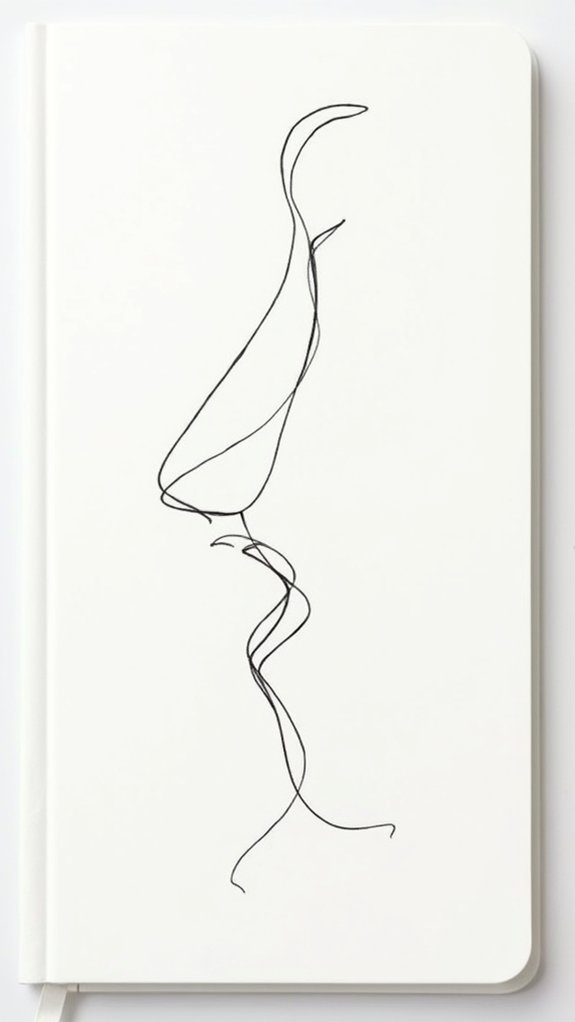
Minimalist line art design is all about keeping things clean and simple, but don’t let that fool you—there’s serious power in those crisp, confident lines.
With expressive, continuous linework and clever use of blank space, a sketchbook cover can go from “meh” to “wow” without a single drop of color.
It’s the kind of style that quietly grabs your attention, making every little curve and detail feel important, almost like the drawing is letting you in on a secret.
Clean and Simple Aesthetics
Picture a single, clean line dancing across a blank page, twisting into shapes or swirling into wild patterns—sometimes it’s a leaf, sometimes just a cool, mysterious squiggle that makes you look twice.
That’s the magic of minimalist line art designs for your sketchbook cover—clean and simple aesthetics that stand out without being loud or messy. With only a few well-placed lines, you get something eye-catching and cool, and there’s freedom to make it your own.
The secret? It’s all about what you leave out as much as what you put in.
- Play with negative space for maximum drama (and bragging rights).
- Try geometric or botanical themes for instant class.
- Use different line weights for surprising depth.
- Invest in quality fine-liners—no regrets!
- Mix everyday objects for a personal, signature twist.
Expressive Continuous Linework
There’s something kind of magical about expressive continuous linework—it’s like a single thread of creativity twisting and turning across the page without ever breaking, capturing movement and feeling all at once.
On sketchbook covers, this style uses just one unbroken line to create minimalistic line art, and honestly, it looks super cool. Even with its simple design, it can show a lot of emotion, like a surprised face or a graceful animal, all drawn without lifting the pen.
Artists mess with line thickness, adding bold spots or whisper-thin sections to make certain features pop. It’s also really personal—everyone draws lines in their own way, so every cover stands out.
Minimalistic line art proves less can actually be way more—no stress, just expression!
Impactful Negative Space
Negative space—sometimes called “the art of nothing”—can turn a regular sketchbook cover into an instant work of genius.
Just imagine, your cover isn’t crowded with wild colors or crazy doodles, but with impactful negative space and bold, minimalist line art that actually catches everyone’s eyes.
The trick is all about knowing when less truly is more, and leaning into those fine details.
- Try sharp, clean lines made with quality fine-liners for that professional vibe.
- Use geometric patterns or flowing organic shapes with lots of breathing room.
- Focus on balancing blank space with intentional lines, making every stroke count.
- Impress friends by showing off restraint—no clutter needed!
- Let the empty areas bake in some mystery, sparking curiosity and conversation.
Less is wow.
Hand-Painted Botanical Illustrations
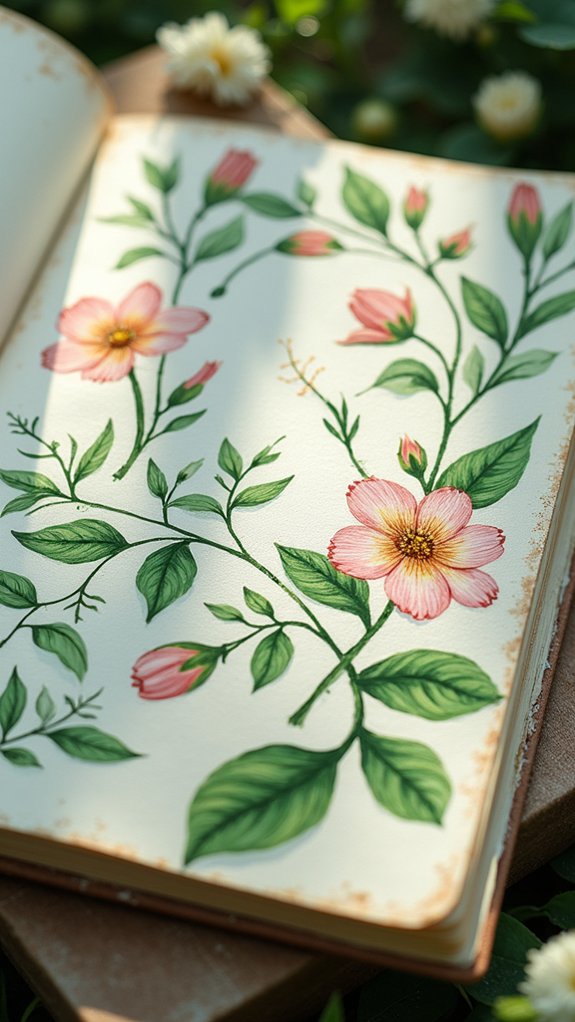
Flowers, leaves, and twisting vines can totally transform a plain sketchbook cover into something magical. Hand-painted botanical illustrations let artists show off tiny details—like the fuzzy edges of a leaf or wild twists in stems.
By using high-quality watercolor or acrylic paints, these covers not only look awesome but also stay bright and fresh even when a backpack takes them on an adventure. Artists sometimes choose local wildflowers or their favorite mysterious plants to add a personal touch.
Mixed media techniques, like adding pencil lines for extra shading or using ink for fine veins, help the artwork really pop. Each leaf, petal, or berry adds a new personality—so your sketchbook isn’t just a supply, it’s your own mini jungle masterpiece!
Bold Mixed Media Abstract Patterns
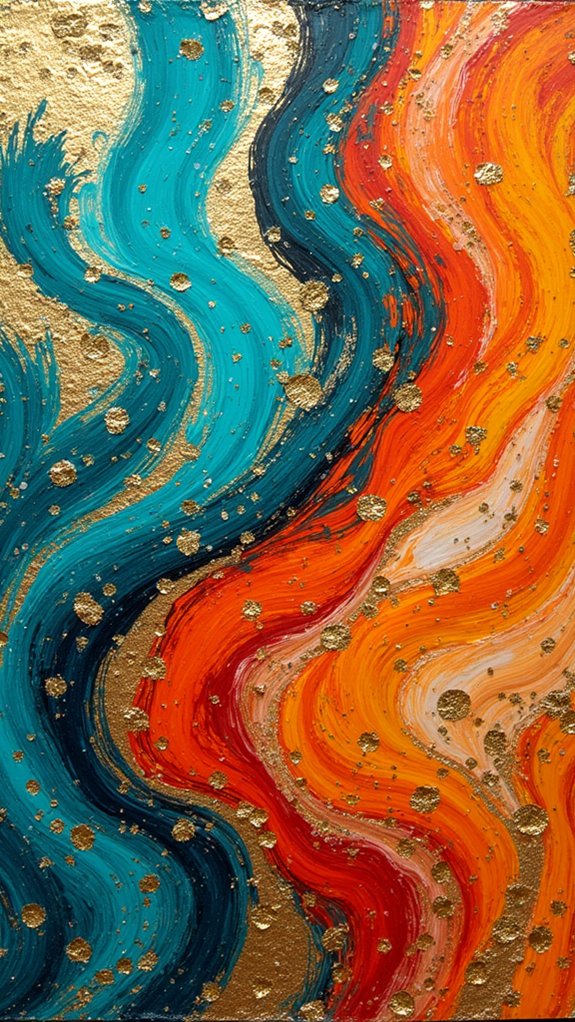
Bold mixed media abstract patterns are all about piling up textures and colors, kind of like making a wild art sandwich—think paint splashes, scraps of shiny paper, and even pieces of old T-shirts.
Artists can experiment with crazy materials, like bubble wrap or even bits of string, while dynamic shapes and lines shoot across the page, making the cover pop with energy.
It’s a freestyle zone where every layer adds a new surprise, and nothing is off-limits except boring.
Layering Textures and Colors
When it comes to making a sketchbook cover that practically explodes with personality, nothing beats layering textures and colors using mixed media.
Imagine this: bold strokes of acrylic paint, splashes of wild color, and scraps of textured paper colliding on your Sketchbook Pages. The process is kind of like making a fancy pizza, but with way less cheese and way more creativity.
To kick things off, try these ideas:
- Start with a wild base layer—mix up bright and dark acrylic paint for instant drama.
- Add texture using bubble wrap or pieces of fabric for a pop of surprise.
- Use sponging, stippling, or scraping to make cool surface effects.
- Grab palette knives, stencils, and brushes to control or let loose with your shapes.
- Leave some layers see-through for visual magic.
Experimenting With Unusual Materials
Art classrooms and messy kitchen tables everywhere can turn into mad science labs when unusual materials start making their way onto sketchbook covers.
Imagine slapping on textured fabrics, bubble wrap, leaves, or even torn-up book pages and watching as your sketchbook transforms from plain to insane. Experimenting with unusual materials for a cover page means ditching the “rules,” grabbing whatever is nearby, and seeing what happens.
Layering acrylic paint, collage bits, or odd textures can create abstract patterns that scream personality. Color blending—like wet-on-wet watercolors—adds extra drama and mood, and a shiny coat of Mod Podge or spray sealant keeps everything safe and glossy.
In the end, every experiment creates a sketchbook cover nobody else could ever copy. That’s pure creative magic!
Dynamic Shapes and Lines
Not every sketchbook cover has to look like it survived a crafting tornado—sometimes, the real magic comes from using sharp shapes and flowing lines to make a first impression that shouts, “Look at me!”
After getting wild with oddball materials, it’s time to play with dynamic patterns that practically jump off the page. Bold mixed media abstract patterns use every trick in the Art and Design toolbox to excite the eyes: geometric shapes meet wiggly lines, gray tones collide with neon streaks, and textures pop everywhere. Mixing materials and colors creates so much energy, you half expect the cover to start dancing.
- Combine geometric and organic shapes for wild movement
- Explore layering paint or collage for serious depth
- Mix bold colors with gray tones for dramatic effects
- Experiment with pastels, markers, even fabric
- Use contrasting backgrounds to highlight dynamic shapes
Personal Monogram With Calligraphy
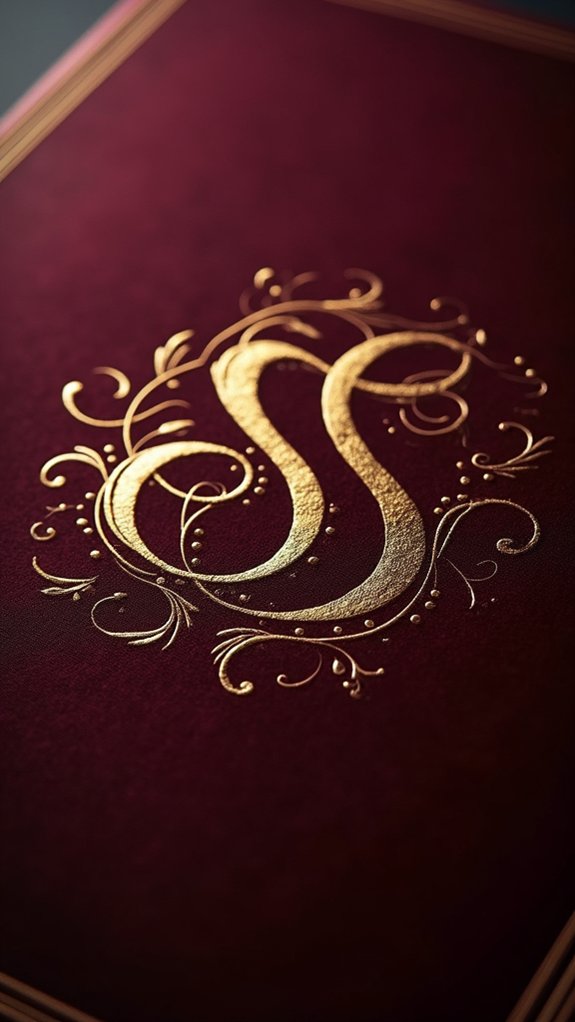
A swooping monogram done in fancy calligraphy can instantly turn a plain sketchbook into something that feels special and totally your own.
Imagine your initials curling and dancing across the sketchbook cover, like they’re putting on a little performance just for you. A personal monogram isn’t just about showing off your name—it’s about putting your unique stamp on your artwork.
Try out different calligraphy styles, from modern bold strokes to delicate, old-school curls. Feel free to experiment with high-quality pens or brushes for extra smooth lines and cool swooshes.
Want to go even bigger? Add some floral doodles or geometric borders around your monogram. The more you practice, the more your sketchbook cover starts feeling like a true piece of art.
Galaxy Theme Watercolor Wash
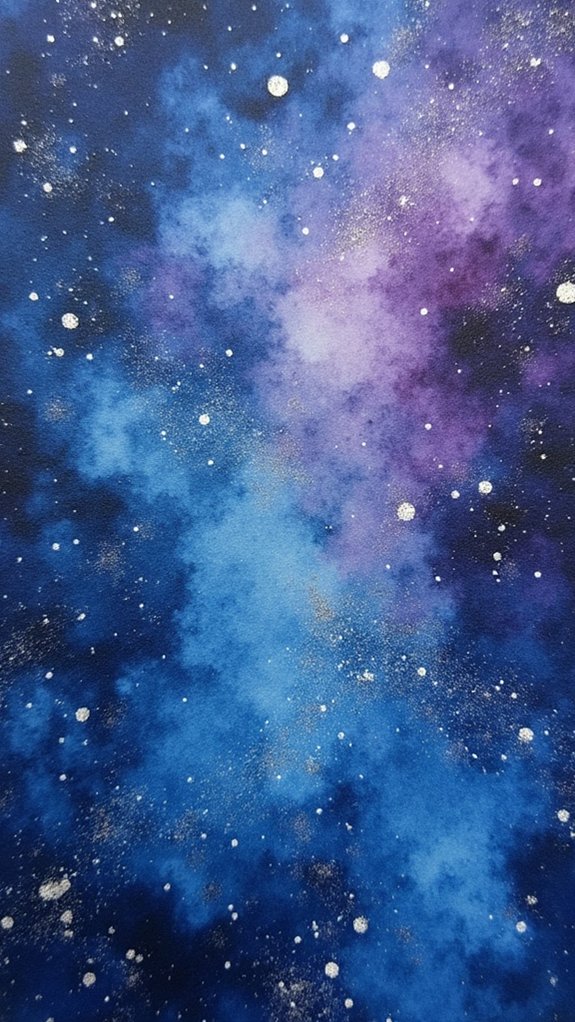
Creating a galaxy theme watercolor wash is like painting your own personal slice of outer space, and it all starts with picking the right materials—think sturdy paper and juicy watercolors.
With simple step-by-step washes, blending wild purples and blues, anyone can start to bring a cosmic look to life, but the real fun begins when adding those bursts of white stars and swirls that look like secret nebula clouds.
It’s messy, creative, and a little bit magical—plus, even if things get chaotic, watercolor has your back!
Essential Materials and Tools
If there’s one thing that’s sure to make a sketchbook cover absolutely pop, it’s a galaxy watercolor wash, and getting it right definitely starts with the right materials.
The secret to out-of-this-world Sketchbook Ideas is using essential materials that set your art apart—no planet-hopping required! Ready to blast off into creativity? Here’s what you’ll want to gather:
- High-quality watercolor paints (think deep blues, purples, and cosmic blacks)
- Watercolor brushes in different sizes for smooth blending and epic layering
- Thick watercolor paper (at least 200 gsm so it won’t warp or wrinkle under all that water)
- White acrylic paint or a toothbrush for awesome star splatters
- Shimmery metallic watercolors or glittery gel pens for that starry-night sparkle
With these tools and materials, every cover is space-tacular!
Step-by-Step Watercolor Techniques
Most artists agree—there’s nothing quite as magical as watching watercolors swirl together to create a galaxy right on the page.
Starting off, you’ll want to use a wide brush to wet your watercolor paper, kind of like prepping a blank School Art canvas for something out of this world. Deep blues, purples, and even touches of black watercolor get layered on while the paper’s still shiny-wet, letting the colors chase each other and blend for that classic cosmic vibe.
Now, here’s the fun (and slightly messy) part—splattering white paint for a sky full of stars! For extra drama, dab in washed-out pinks and teals for those ethereal nebula clouds.
Analyzing the work when it dries? You might just feel like an astronaut gawking at the universe!
Adding Celestial Details
Stardust magic happens when ordinary watercolor washes get upgraded with a few bold, celestial details.
Taking a sketchbook cover page from simple to absolutely cosmic is easier than it sounds, and a galaxy theme packs a lot of visual punch. The secret? Blending deep blues, purples, and blacks for a dreamy base, then sprinkling starlight everywhere!
With a pinch of patience, anyone can nail this out-of-this-world art style.
- Blend diluted blues, purples, and blacks for a smooth galaxy sky effect.
- Spatter white paint with a brush or toothbrush for clusters of tiny “stars.”
- Drop in pink and teal watercolors for glowing nebula clouds.
- Layer on planets, moons, or funky constellations for a show-stopping focal point.
- Let layers dry, experiment, and embrace happy art accidents!
Whimsical Character Portraits

Plenty of sketchbook covers come to life with a splash of whimsy, especially when they feature character portraits that are anything but ordinary.
It’s like pulling up a chair at the world’s silliest tea party every time someone opens to the first page! With big, goofy eyes, wild hair that looks straight out of a bedtime story, and bold, bright colors everywhere, these portraits are meant to make you smile.
Artists plunge into fairy tales, cartoons, or even their favorite old myths, mixing and matching ideas for truly unique faces. Adding quirky details—think rainbow hats or a dragon sidekick—amps up the fun.
Sometimes, traditional drawings get a digital upgrade, resulting in covers that make every “first page” adventure unforgettable.
Stitched Fabric and Textile Cover
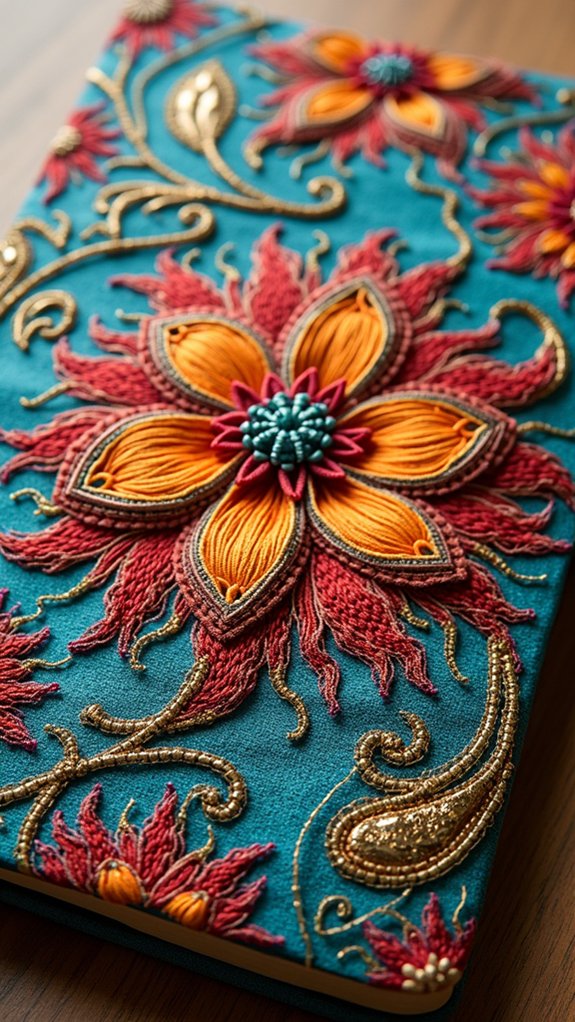
Using stitched fabric and textile covers for your sketchbook means you get to pick from all kinds of awesome materials—old jeans, a wild patterned shirt, or maybe even grandma’s tablecloth if she’s cool with it!
Choosing your fabrics is just part of the fun, because you can also hand-stitch personal designs, like your initials, goofy faces, or favorite animals right onto the cover.
Imagine showing off a sketchbook that’s soft, colorful, and basically shouting, “This is so you!”
Exploring Textile Material Choices
A splash of colorful fabric can turn a plain sketchbook into something truly eye-catching and personal. When choosing textile material for a stitched sketchbook cover, the options can feel endless—and a little overwhelming, in the best way!
Each material or method totally changes the vibe. Textile techniques, like layering or dyeing, can add surprises you didn’t expect. Fabric textures—think soft cotton, grainy linen, or fuzzy felt—invite curious fingers to explore.
Embroidery designs stitched across the front bring instant wow-factor, letting creativity shine before anyone even opens the book.
- Choose fabric textures for a tactile cover
- Test out unique textile techniques for custom effects
- Add embroidery designs for instant personality
- Pick bright prints or calming solids to match your style
- Mix and match textiles for double the fun
Who knew fabric had so much personality?
Hand-Stitching Personal Motifs
Even though sketchbooks usually hide their best secrets inside, there’s something seriously cool about making the cover just as personal. Hand-stitching personal motifs lets artists turn their sketchbook into a unique, touchable work of art.
Choosing strong textile choices, like cotton or linen, means the cover can take on adventures without falling to pieces. Want extra flair? Mixing up stitching techniques—think satin stitch, backstitch, or even some wild appliqué—makes any motif pop.
Motif inspiration can come from anywhere: doodles, favorite animals, or even random squiggles during math class. For bonus points, beads or buttons can be stitched on for the ultimate wow-factor.
A strong backing, like felt or interfacing, keeps everything sturdy, so the masterpiece survives being tossed in backpacks.
Kraft Paper With Ink Illustrations
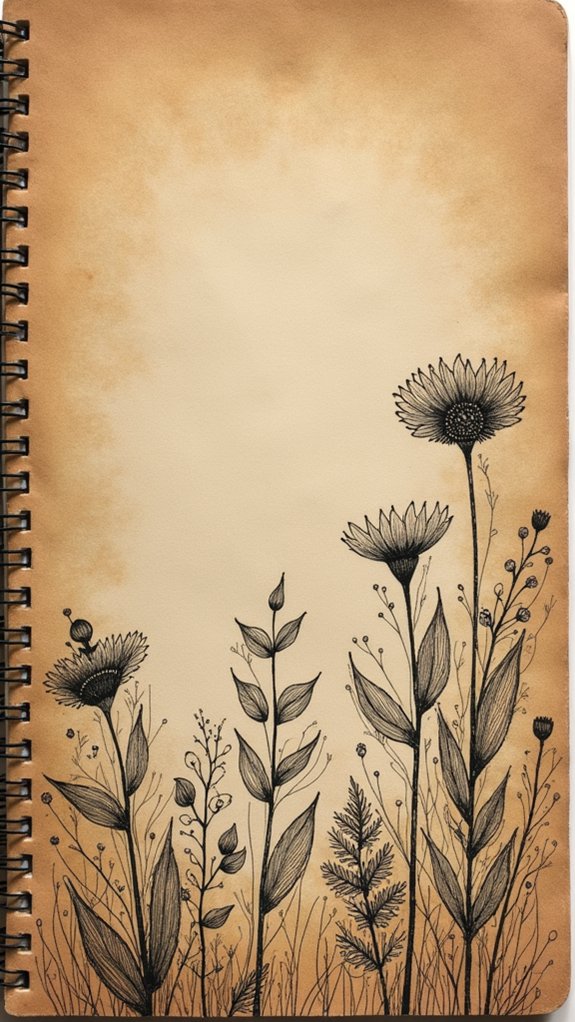
Brown kraft paper, with its rough, earthy texture, is almost like a blank treasure map waiting for adventure. Choosing kraft paper for a sketchbook cover means you’re not just drawing—you’re making a statement. Its sturdy surface gives ink illustrations a rustic aesthetic appeal that feels both handmade and totally cool.
The way ink interacts with kraft paper is magical; you get ink texture effects like feathering and bold lines that just pop. Plus, if you’re into eco friendly artistry, kraft paper’s sustainable background is a big win.
- Highlights contrast between dark ink and warm paper
- Shows off detailed, crisp line work
- Enhances rustic, earthy vibes for extra charm
- Offers eco-friendly credibility with recycled materials
- Lets artists experiment with fun ink texture effects
Nature-Inspired Mountain Landscapes

If kraft paper brings a rustic vibe to a sketchbook, nature-inspired mountain scenery takes it up a notch with epic views straight from the wild. Just imagine a cover with jagged peaks, rolling hills, and maybe some misty clouds sneaking behind the mountain tops.
Using mountain silhouette techniques, artists can layer different heights and shapes, letting darker shades melt into lighter ones—like a sunrise over your favorite campsite. Grab nature color palettes with earthy browns, deep greens, or sky blues, and you’ve got something that feels real and rugged.
For a personal twist, throw in sketches of wildlife or favorite hiking spots—talk about outdoor adventure inspirations right on your cover! Whether you use watercolor, pencils, or even textured paper, your sketchbook will practically beg for adventure.
Energetic Graffiti or Street Art Motifs
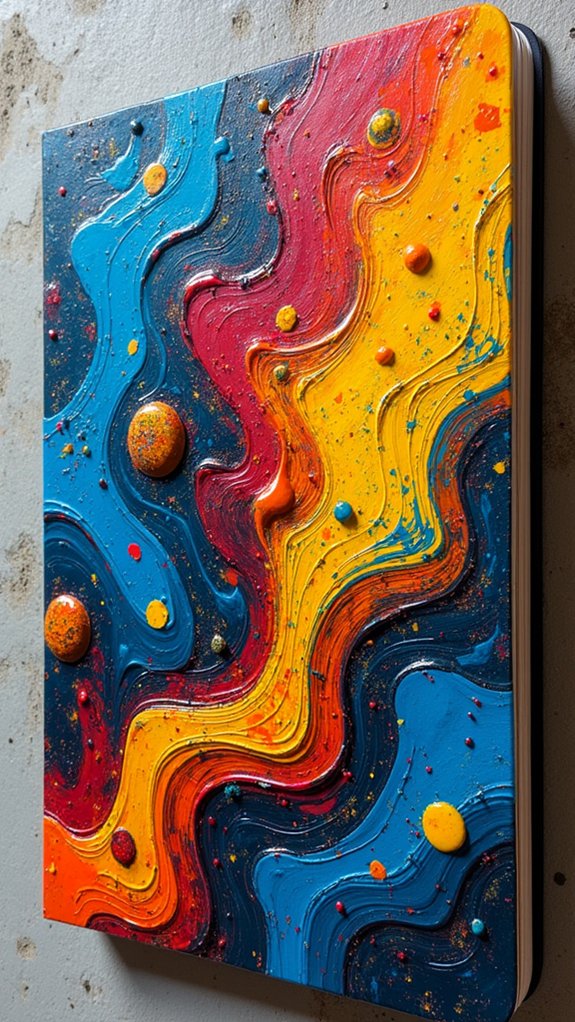
For a sketchbook cover that’s bursting with energy, graffiti or street art vibes are hard to beat—think bold color splashes that look almost explosive, tags and lettering layered on like secret codes, and gritty textures that scream “city life.”
Want your cover to pack a punch? Grab markers, splash some paint, and don’t be afraid to add wild shapes or that sticker you found in your backpack for extra urban flair.
Bold Color Splash Techniques
When it comes to making a sketchbook cover pop with energy, bold color splash techniques are like turning the volume up to max. These styles take inspiration from graffiti history and urban art styles, using bright splashes, drippy lines, and wild shapes to demand attention.
They’re perfect for artists who want their cover to be just as creative as what’s inside. Playing with color theory exploration is part of the fun—will you go neon, clash colors, or try a rainbow riot? Big, messy strokes and wild choices are welcome here.
- Explore vibrant paints, markers, or even spray paint for an edgy feel
- Try stencils for controlled splashes mixed with loose, freehand drips
- Use contrasting colors for high-energy effects
- Add rough, bold outlines for drama
- Experiment with splatter and abstract urban motifs
Layered Tags and Lettering
Lettering takes center stage in street art-inspired sketchbook covers, bursting with life through layered tags and wild graffiti motifs.
Imagine a cover where bold letters crash together, overlapping in a wild dance that grabs your attention—almost like the walls of a city just woke up and started yelling “Notice me!”
Artists use layered typography techniques, letting one word peek out from behind another, or mix wild letters with funky street art influences like arrows, drips, or comic-style bursts.
Vibrant color combinations make things pop: hot pinks, electric blues, and neon greens all mashed together.
Markers, spray paints, and stencils can give the letters a super cool, gritty texture.
The result? Covers that are alive, energetic, and totally unforgettable—no snooze-fest here!
Urban Texture Inspirations
A burst of city energy can turn a plain sketchbook cover into something impossible to ignore.
Urban texture inspirations take the wild style of the streets—think graffiti techniques, bold splashes of color, and the unpredictable charm of street art—to make covers that practically shout, “Look at me!”
The secret? It’s all about mixing textures, stories, and personal vibes into one supercharged design.
If you’re ready to let those urban aesthetics loose, check out these ideas:
- Use stencils or spray paint effects for that authentic city vibe
- Layer drip painting and splatter marks for wild, dynamic textures
- Mix in edgy typography, like street signs and iconic slogans
- Collage ticket stubs or old bus maps for a gritty, personal touch
- Play with bold, clashing color combos for maximum impact
Geometric Shapes With Washi Tape
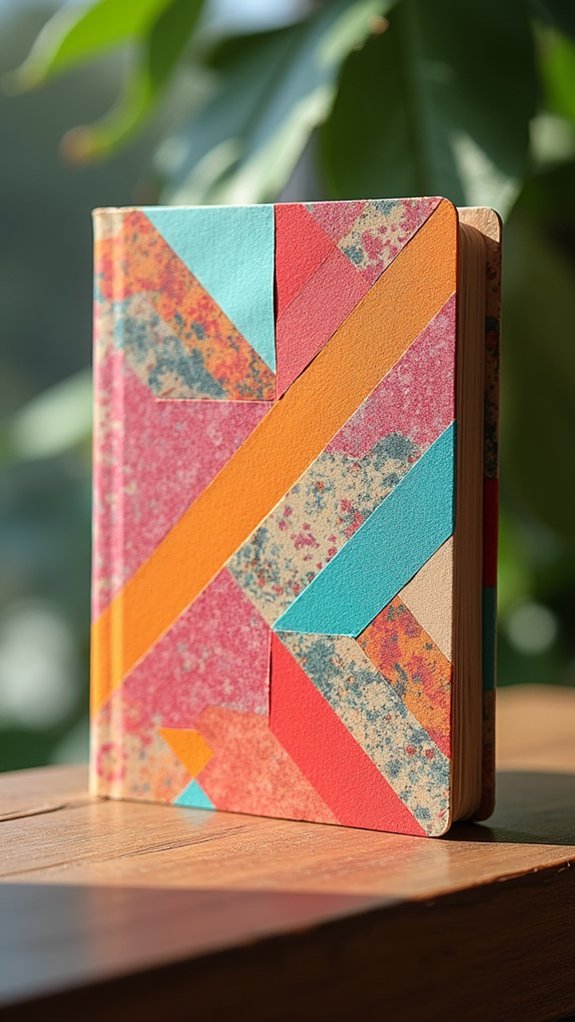
Countless sketchbook cover designs get way more exciting with washi tape and a few cool geometric shapes. This combo is basically a party for your eyes—thanks to all the awesome washi tape patterns out there.
Start by sketching your favorite triangles, squares, or wild polygon shapes lightly in pencil, just to map things out. Next comes the fun part: using those funky tapes! Play around with geometric layering, overlapping stripes with polka dots, or sneaking in some floral designs for a surprise pop.
Washi tape is super lightweight and, let’s be real, forgiving—so if you mess up, no worries. It peels right off for easy fixes.
Hand-Lettered Motivational Quote
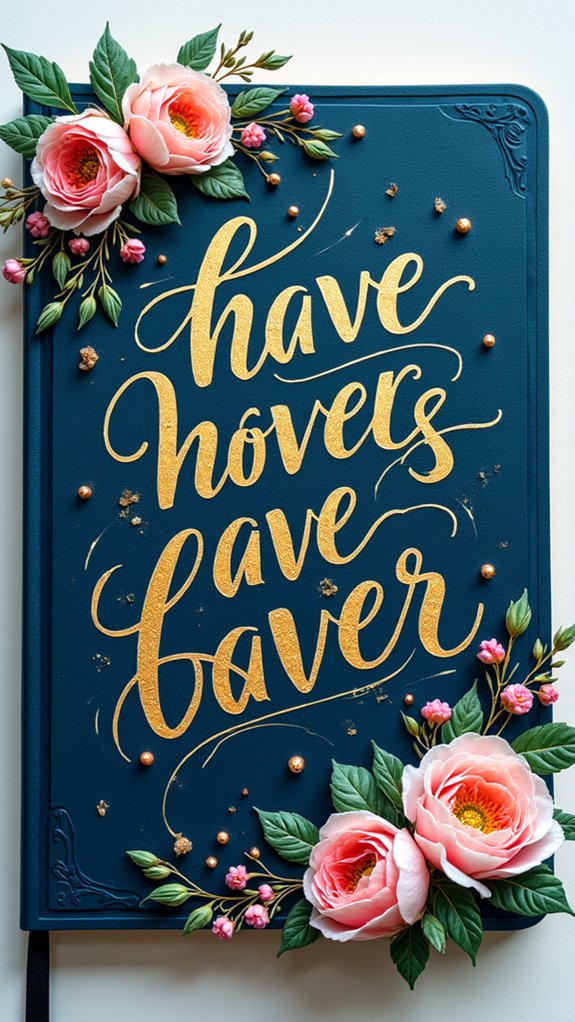
Sometimes a bold, hand-lettered motivational quote is all it takes to turn a plain sketchbook cover into something seriously inspiring. The magic starts with quote selection; picking a phrase that lights a fire in your heart makes every doodle session feel epic.
Using different hand lettered techniques, like brush lettering or swoopy calligraphy, amps up the personality big time. Add some doodles or decorative swirls, and suddenly, your sketchbook isn’t just a book—it’s a pep talk you can carry.
To help out, check out these design inspiration tips:
- Choose a quote that genuinely inspires you
- Experiment with hand lettered techniques for unique style
- Highlight the quote using bold colors or metallic pens
- Add simple illustrations or doodles for extra flair
- Use durable pens or markers to keep everything looking fresh
Dried Flowers and Transparent Elements
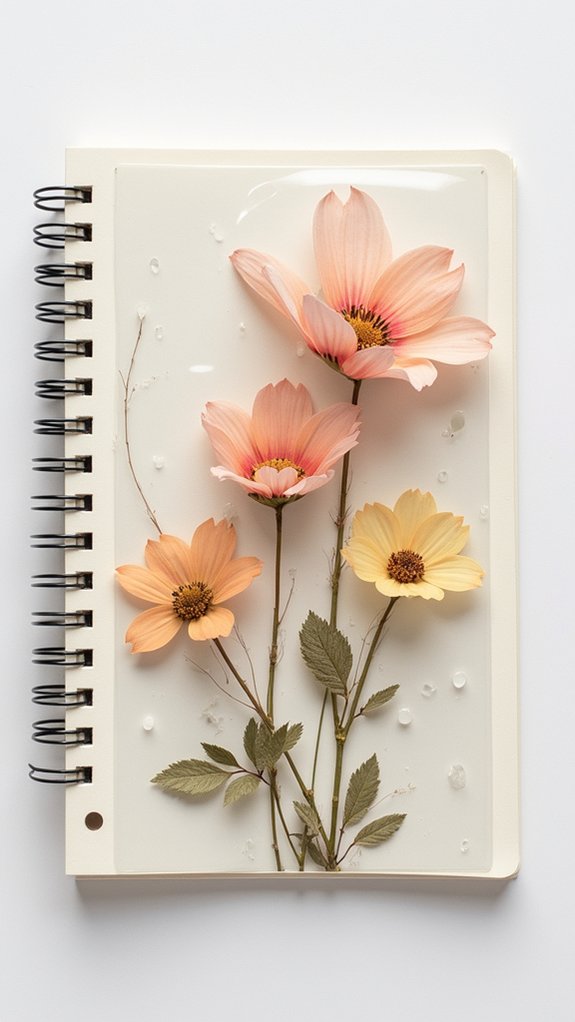
Once a sketchbook cover gets the perfect quote blasting out motivation, things can get even more magical by bringing in a piece of the real world—literally.
Imagine this: pressed flowers, picked up from a favorite park or backyard adventure, preserved forever on your sketchbook using dried flower preservation methods. It instantly adds those charming nature inspired aesthetics, and, honestly, who wouldn’t want a cover that feels like a memory you can touch?
To level it up, try transparent layering techniques—think clear adhesive sheets or laminating the flowers between plastic. This not only protects your little botanical treasures but also lets them shine through, creating cool depth and texture.
It’s eco-friendly, personal, and way more interesting than any store-bought cover.
Pop Culture Collage With Magazine Cutouts
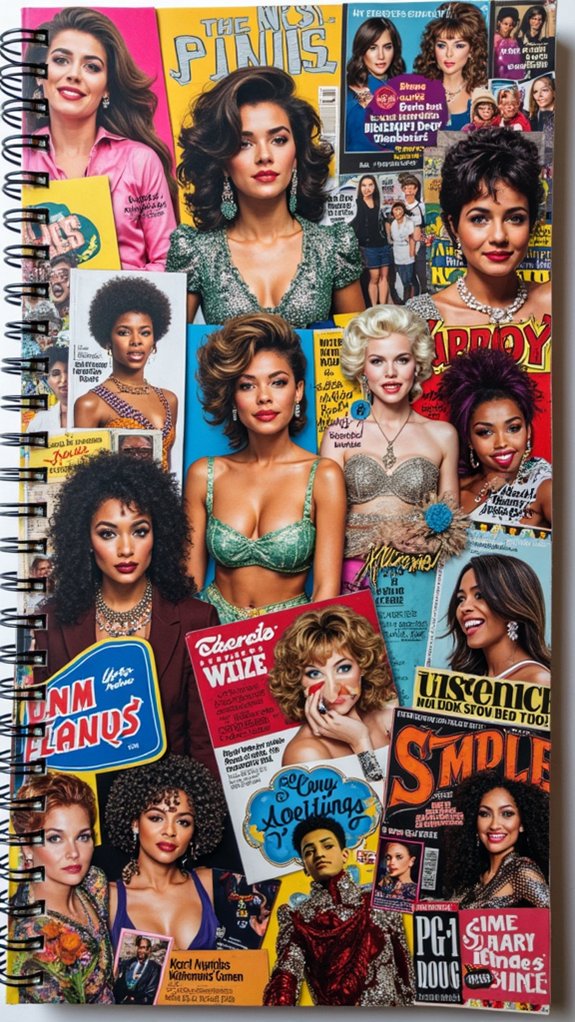
Magazines are a goldmine for anyone itching to show off their favorite pop culture icons, and turning those glossy pages into a collage is like making your own VIP red carpet—right on your sketchbook.
Whether you’re obsessed with celebrity imagery, the latest fashion, or just a catchy meme, a pop culture collage delivers bold, contemporary themes straight to your cover. Layering images creates a dynamic visual narrative and keeps things interesting every time you open your book.
Here’s how to get started:
- Hunt for magazines with celebrities, movies, and music for diverse cutouts.
- Experiment with arrangements before gluing anything down.
- Mix in cool text snippets, like quotes or song lyrics.
- Layer and overlap pieces for extra depth and eye-catching style.
- Leave some background showing for balance and flair.
Chalk Pastel Dreamscape
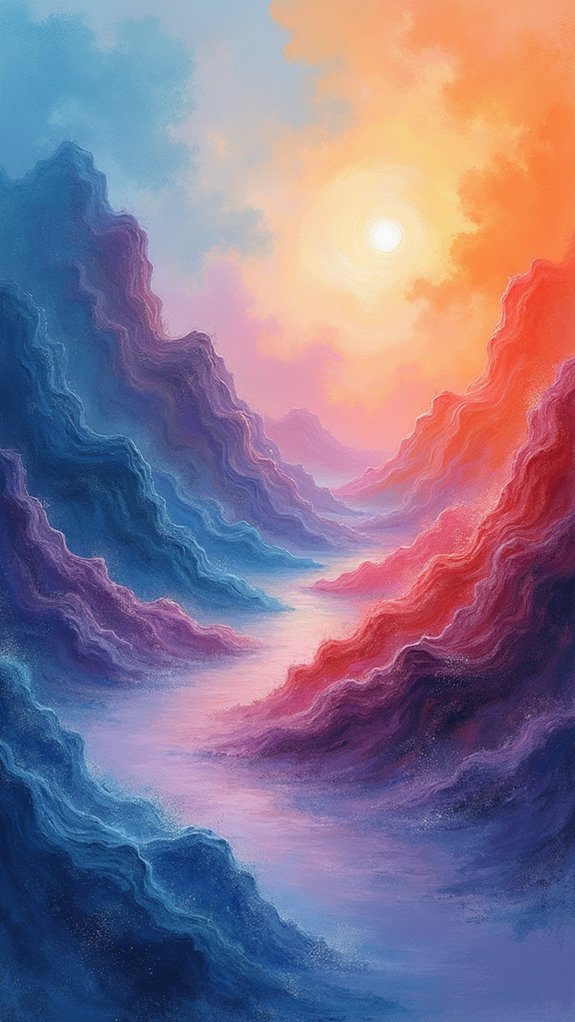
Even if a rainy day keeps everyone stuck inside, chalk pastels can turn a boring old sketchbook into a portal to another world—no expensive art supplies required.
With just a few sticks of chalk pastel, anyone can start sweeping dreamy vistas right across a cover. Think soft clouds, swirling skies, and magical colors all melting together in ways that feel almost impossible.
Pastel blending is where the real fun happens—smudge colors with fingers or blending stumps, and watch them come alive like magic fog. Layering shades brings extra depth, so your dreamscape looks endless.
Whimsical elements like floating stars or abstract swirls make everything pop and keep things playful. Just spritz the finished masterpiece with fixative, and voilà—your cover is protected and ready for dream adventures!
Playful Doodle Explosion

A doodle explosion is basically what happens when a sketchbook cover decides to party. It bursts with doodle character creation, vibrant color combinations, and wild abstract shape exploration that seems to go on forever.
This cover style isn’t shy—it grabs attention and tells everyone that something awesome is happening inside. From quirky creatures to twisty patterns, the cover becomes a nonstop celebration of creative ideas.
Want yours to stand out even more? Try:
- Mixing doodle characters with silly expressions for a playful vibe
- Using vibrant color combinations that practically jump off the page
- Filling empty spaces with abstract shape exploration and swirls
- Adding mixed media like washi tape for surprise textures
- Layering patterns and colors to make it uniquely eye-catching
Let your doodle explosion spark curiosity!
Architectural Sketches in Monochrome
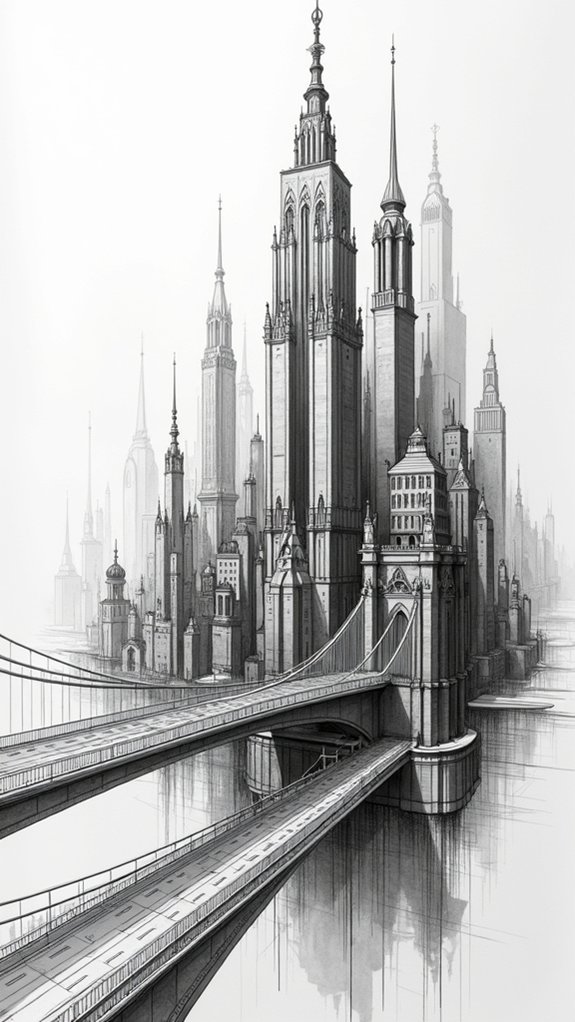
When someone flips open a sketchbook and spots an architectural sketch in sleek black, white, and delicious shades of gray, there’s a certain “wow” factor that’s hard to ignore.
With just a few bold lines and clever shading, monochrome depth exploration becomes the star of the show. It’s like the buildings leap right off the page!
Artists use structural contrast techniques—think cross-hatching or stippling—to make details pop and walls feel almost touchable.
Plus, all those moody grays? They turn regular city scenes into architectural mood representation masterpieces.
Without color to distract you, the shapes and shadows take you on a tour through towers, bridges, or cozy houses.
Monochrome sketches keep things classy, powerful, and extra dramatic—a real showstopper for any cover.
Glitter, Foil, and Metallic Accents
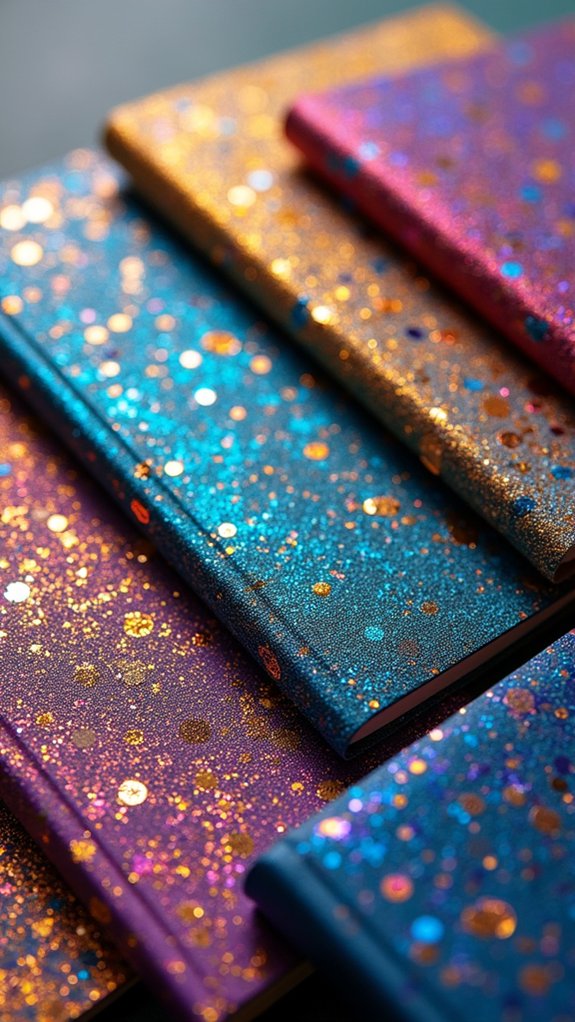
Who says sketchbook covers have to play it safe with just black, white, and gray? Go bold—add some bling!
Glitter techniques, foil layers, and metallic contrasts can turn an ordinary cover into a dazzling statement. These shiny details aren’t just for show; they broadcast confidence and creativity while making your sketchbook the star of any pile.
If you want cover art that practically shouts, “Open me!” check out these ideas:
- Try foil stamping for cool reflective patterns on dark or matte backgrounds.
- Use loose glitter or adhesive glitter sheets for splashy, no-fuss magic.
- Accent titles or borders with metallic paint pens for sharp, eye-popping contrast.
- Layer different metallic accents for extra drama.
- Always seal your work with Mod Podge for lasting sparkle and shine!
Washable Marker Rainbow Art
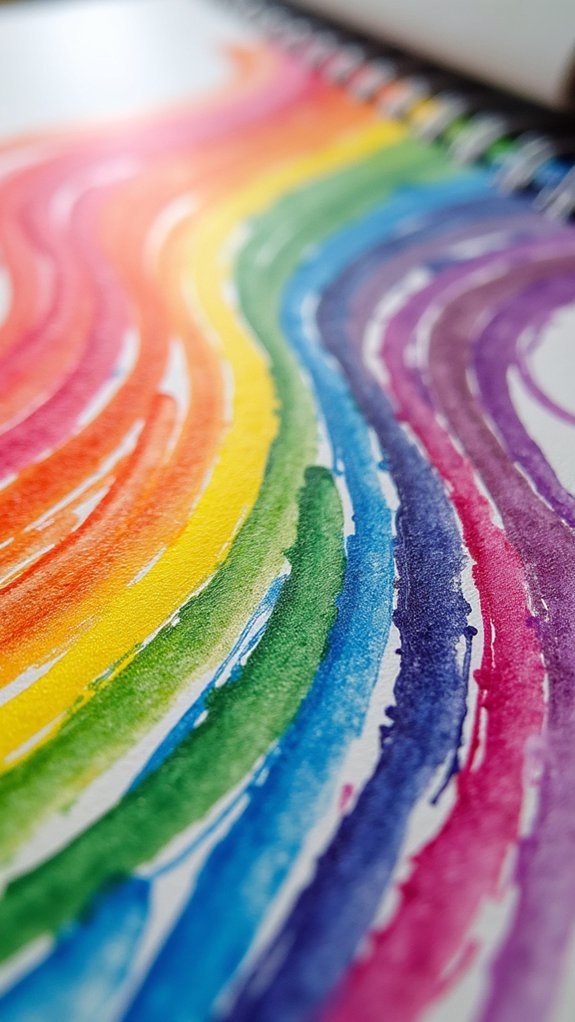
Nothing says “happy sketchbook” quite like a splash of rainbow colors straight across the cover.
Washable marker rainbow art lets anyone turn a plain notebook into a show-stopping masterpiece. Start by choosing your most vibrant color combinations—pick out all the reds, oranges, blues, and greens you love.
Lay down stripes, or go with wild arcs, blending each color into the next for that smooth, almost-magical marker blending technique. Want even more pop? Lightly swipe a damp brush over the marker lines and watch the colors melt together, giving you a watercolor look.
Add personalized design elements like doodled clouds, a quirky sun, or even sparkly raindrops. Just make sure everything dries before showing off your new cover—nobody needs rainbow fingers at school!
Mosaic of Personal Photo Memories
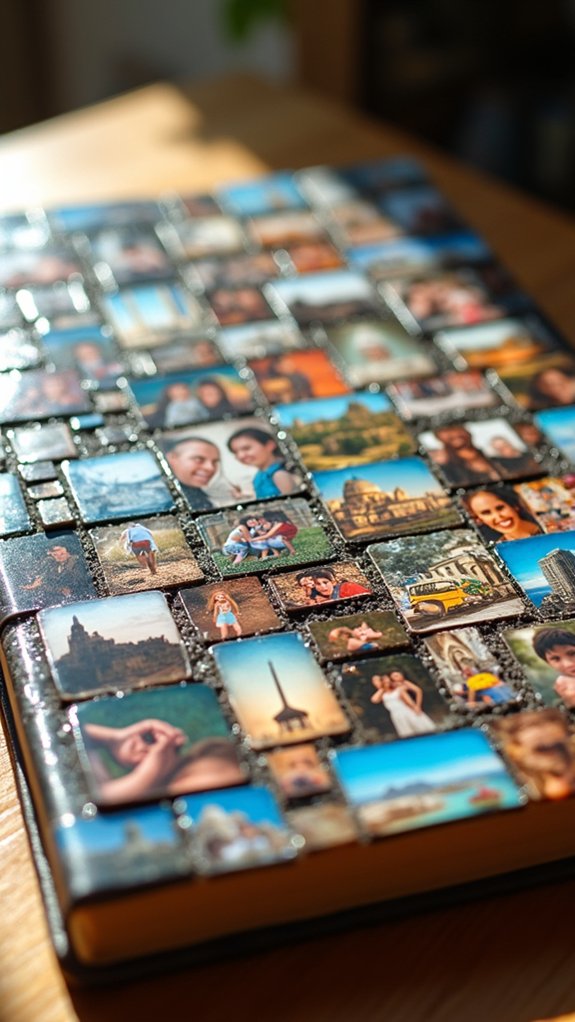
Photographs can turn an ordinary sketchbook into a total time machine, packed with laughter, adventures, and those goofy moments only you will understand.
Making a mosaic of personal photo memories for your cover page is like building a scrapbook that fits in your hand. It’s all about personal nostalgia, transforming a simple cover into a piece of visual storytelling.
For a creative arrangement, pick photos that mean a lot—maybe your first roller coaster ride, your pet’s derpiest face, or that cool sunset from vacation.
- Choose photos that spark big emotions or fun memories
- Use editing apps to arrange the images into a neat collage
- Add handwritten notes or dates for extra meaning
- Stick the finished mosaic to your cover
- Seal it with Mod Podge for protection and shine
Frequently Asked Questions
What Should I Put on the Front of My Sketchbook?
When considering what to put on the front of a sketchbook, one might explore sketchbook themes, include inspiring artistic quotes, or add personal symbols that resonate with their creative vision, ensuring the cover expresses individual style and intent.
What to Draw 100 Ideas?
When wondering what to draw, one might consider exploring abstract patterns, intricate geometric shapes, detailed nature scenes, daily life objects, fantasy creatures, expressive faces, architectural studies, imaginative vistas, and playful doodles, ensuring abundant variety and creative inspiration.
How to Cover up a Bad Drawing?
When addressing how to cover up a bad drawing, one can explore drawing techniques and creative solutions such as layering, collage, or overlays, which not only hide mistakes but also build artistic confidence through experimentation and transformation.
How to Protect Your Sketchbook Cover?
Protecting a sketchbook cover involves selecting durable sketchbook materials, applying protective coatings such as acrylic spray or laminating film, and reinforcing edges with tape. Additionally, storing custom cover designs in sleeves or cases reduces exposure to environmental damage.
Conclusion
Sketchbook covers aren’t just protective shields—they’re a chance to show off a little (or a lot) of your personality. Whether you love glitter explosions, delicate flowers, or cool vintage collages, there’s an idea here that’ll make your sketchbook scream, “Hey, this is me!” So pick a favorite, grab your art supplies, and get messy. After all, it’s your sketchbook—the rules are pretty much yours to break, unless your cat gets involved. Then all bets are off.

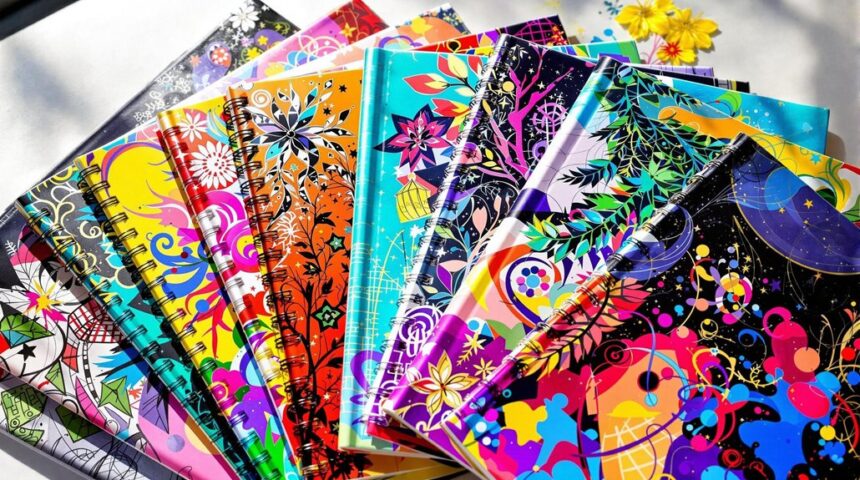
Leave a Reply